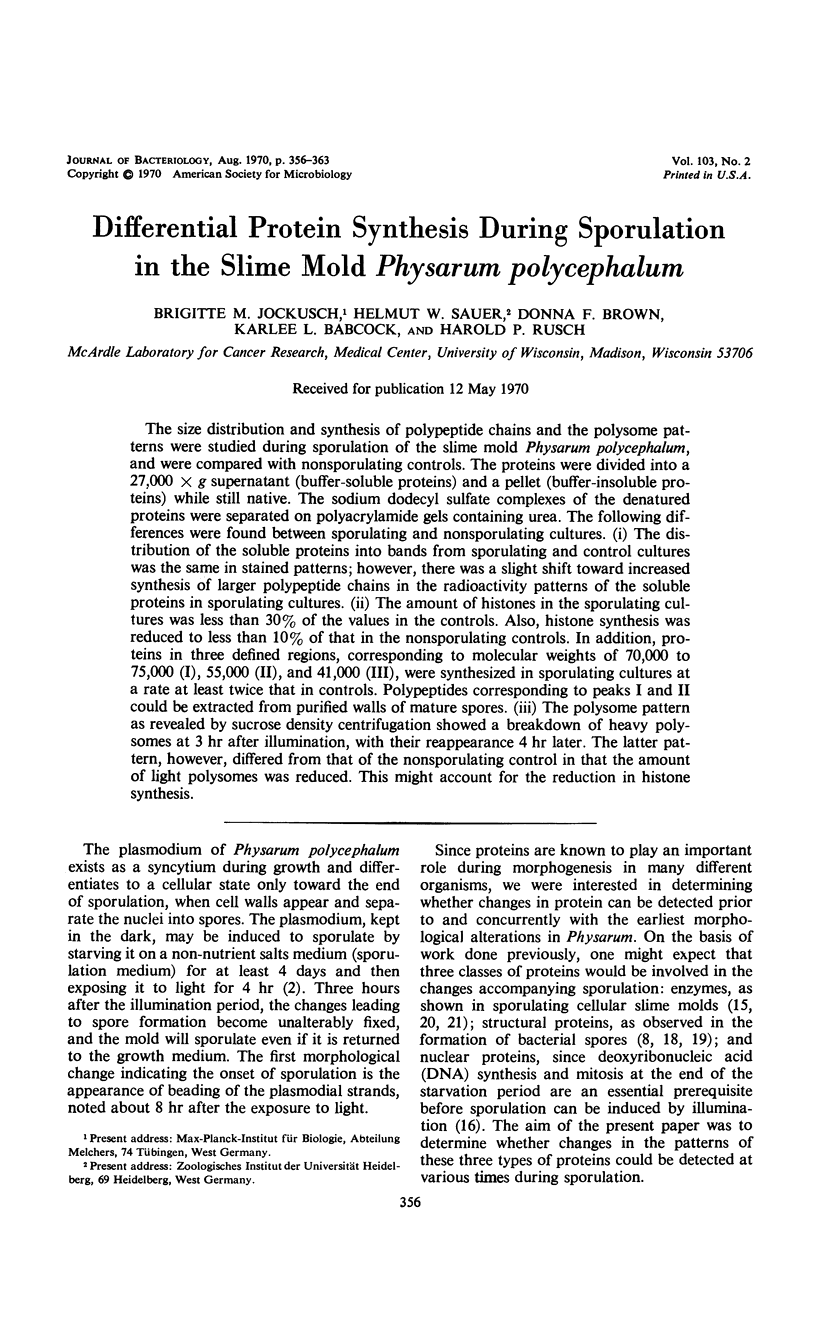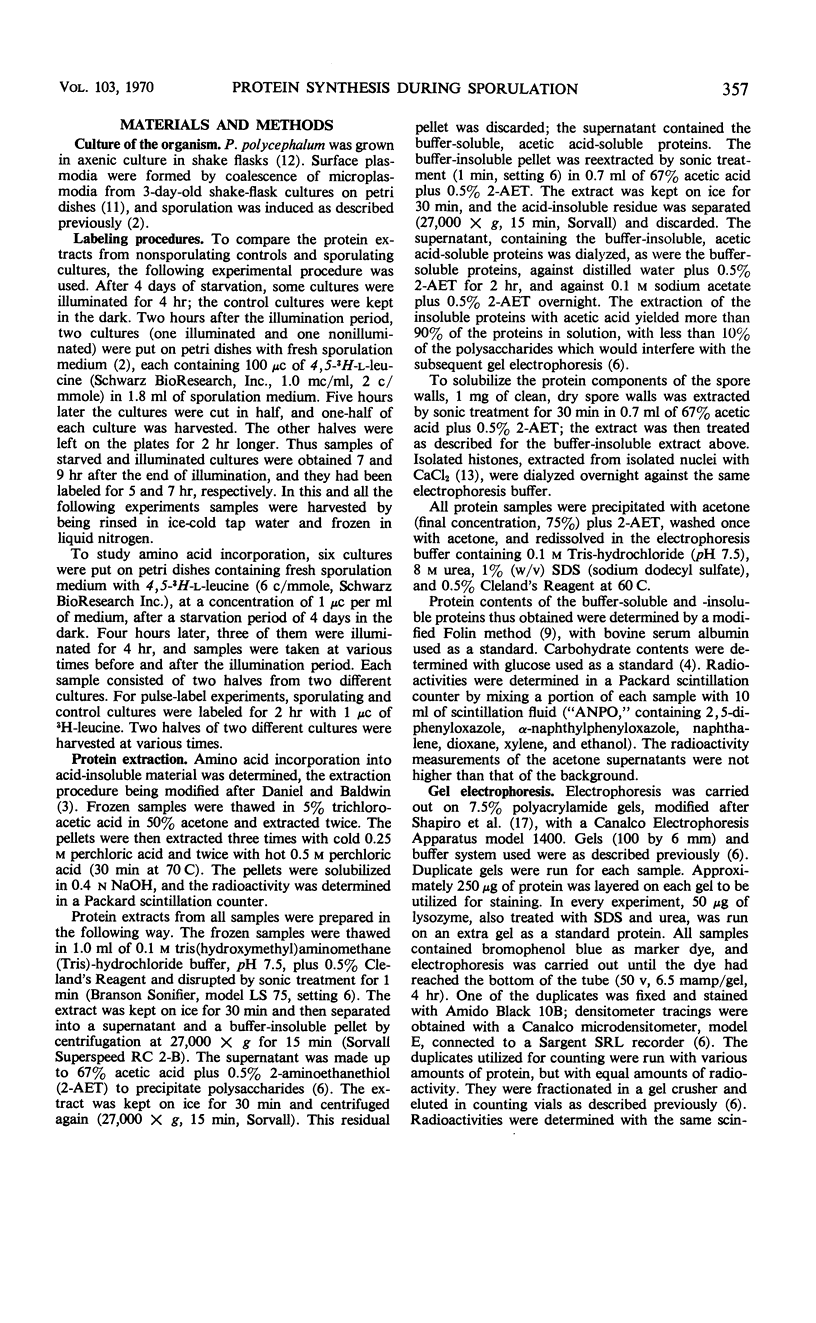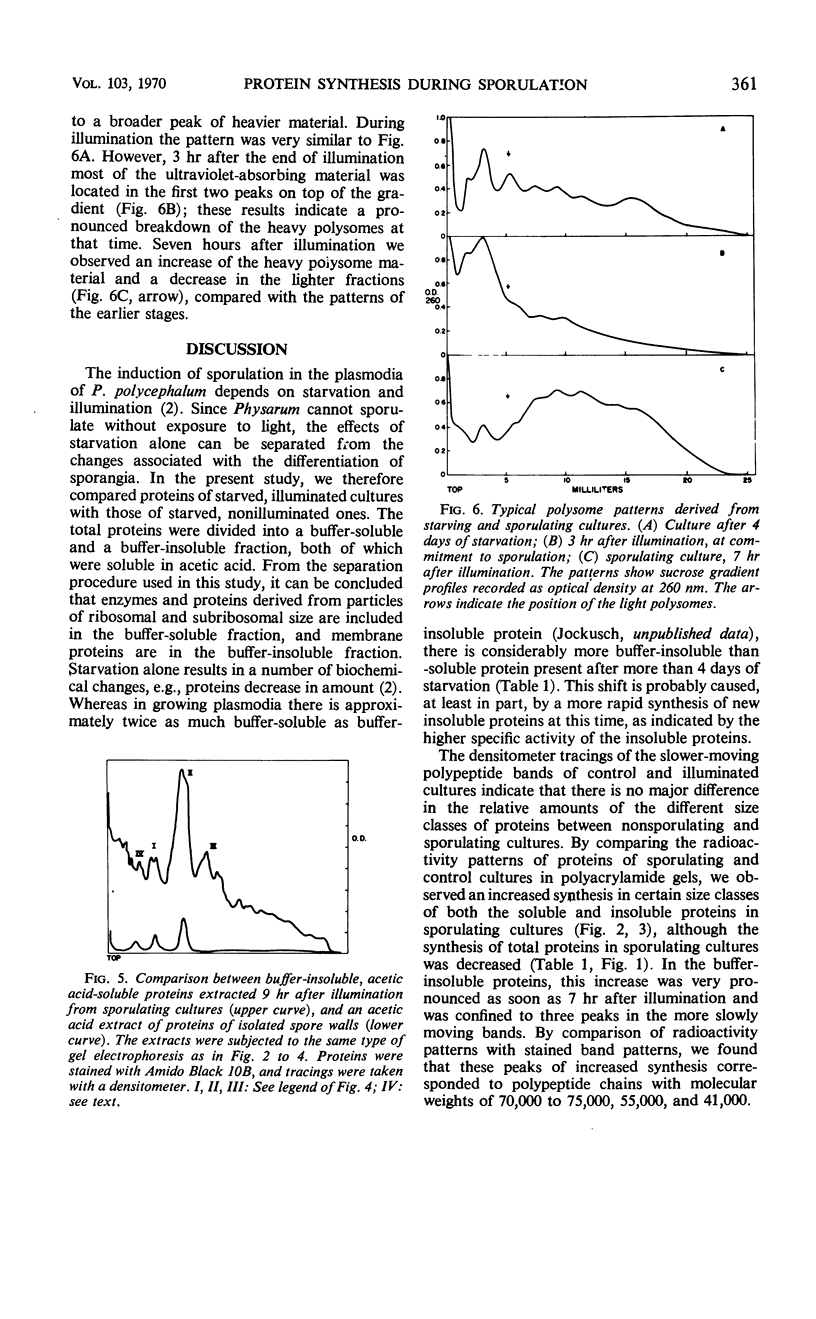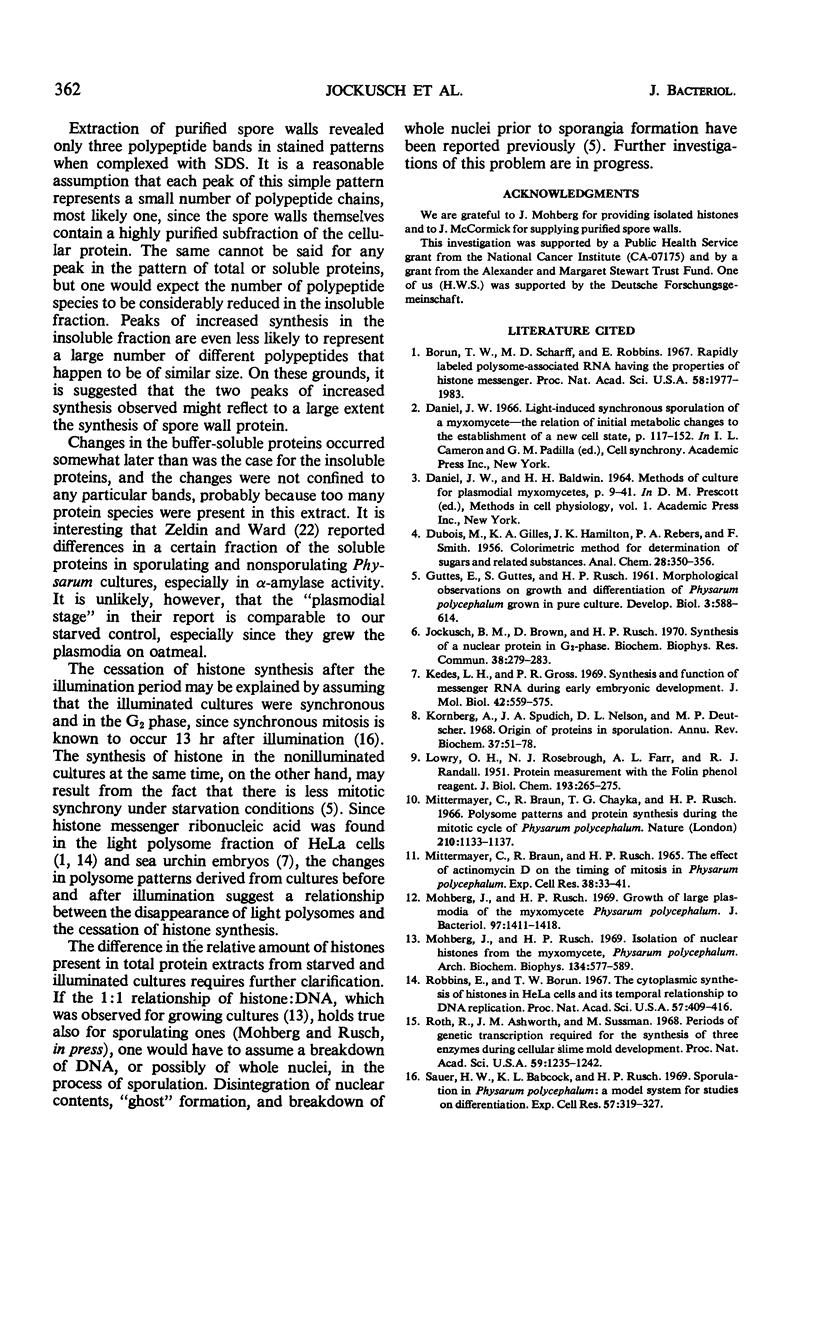Abstract
The size distribution and synthesis of polypeptide chains and the polysome patterns were studied during sporulation of the slime mold Physarum polycephalum, and were compared with nonsporulating controls. The proteins were divided into a 27,000 × g supernatant (buffer-soluble proteins) and a pellet (buffer-insoluble proteins) while still native. The sodium dodecyl sulfate complexes of the denatured proteins were separated on polyacrylamide gels containing urea. The following differences were found between sporulating and nonsporulating cultures. (i) The distribution of the soluble proteins into bands from sporulating and control cultures was the same in stained patterns; however, there was a slight shift toward increased synthesis of larger polypeptide chains in the radioactivity patterns of the soluble proteins in sporulating cultures. (ii) The amount of histones in the sporulating cultures was less than 30% of the values in the controls. Also, histone synthesis was reduced to less than 10% of that in the nonsporulating controls. In addition, proteins in three defined regions, corresponding to molecular weights of 70,000 to 75,000 (I), 55,000 (II), and 41,000 (III), were synthesized in sporulating cultures at a rate at least twice that in controls. Polypeptides corresponding to peaks I and II could be extracted from purified walls of mature spores. (iii) The polysome pattern as revealed by sucrose density centrifugation showed a breakdown of heavy polysomes at 3 hr after illumination, with their reappearance 4 hr later. The latter pattern, however, differed from that of the nonsporulating control in that the amount of light polysomes was reduced. This might account for the reduction in histone synthesis.
Full text
PDF







Selected References
These references are in PubMed. This may not be the complete list of references from this article.
- Borun T. W., Scharff M. D., Robbins E. Rapidly labeled, polyribosome-associated RNA having the properties of histone messenger. Proc Natl Acad Sci U S A. 1967 Nov;58(5):1977–1983. doi: 10.1073/pnas.58.5.1977. [DOI] [PMC free article] [PubMed] [Google Scholar]
- GUTTES E., GUTTES S., RUSCH H. P. Morphological observations on growth and differentation of Physarum polycephalum grown in pure culture. Dev Biol. 1961 Oct;3:588–614. doi: 10.1016/0012-1606(61)90034-3. [DOI] [PubMed] [Google Scholar]
- Jockusch B. M., Brown D. F., Rusch H. P. Synthesis of a nuclear protein in G2-phase. Biochem Biophys Res Commun. 1970 Jan 23;38(2):279–283. doi: 10.1016/0006-291x(70)90709-6. [DOI] [PubMed] [Google Scholar]
- Kedes L. H., Gross P. R. Synthesis and function of messenger RNA during early embryonic development. J Mol Biol. 1969 Jun 28;42(3):559–575. doi: 10.1016/0022-2836(69)90243-5. [DOI] [PubMed] [Google Scholar]
- Kornberg A., Spudich J. A., Nelson D. L., Deutscher M. P. Origin of proteins in sporulation. Annu Rev Biochem. 1968;37:51–78. doi: 10.1146/annurev.bi.37.070168.000411. [DOI] [PubMed] [Google Scholar]
- LOWRY O. H., ROSEBROUGH N. J., FARR A. L., RANDALL R. J. Protein measurement with the Folin phenol reagent. J Biol Chem. 1951 Nov;193(1):265–275. [PubMed] [Google Scholar]
- MITTERMAYER C., BRAUN R., RUSCH H. P. THE EFFECT OF ACTINOMYCIN D ON THE TIMING OF MITOSIS IN PHYSARUM POLYCEPHALUM. Exp Cell Res. 1965 Apr;38:33–41. doi: 10.1016/0014-4827(65)90424-6. [DOI] [PubMed] [Google Scholar]
- Mittermayer C., Braun R., Chayka T. G., Rusch H. P. Polysome patterns and protein synthesis during the mitotic cycle of Physarum polycephalum. Nature. 1966 Jun 11;210(5041):1133–1137. doi: 10.1038/2101133a0. [DOI] [PubMed] [Google Scholar]
- Mohberg J., Rusch H. P. Growth of large plasmodia of the myxomycete Physarum polycephalum. J Bacteriol. 1969 Mar;97(3):1411–1418. doi: 10.1128/jb.97.3.1411-1418.1969. [DOI] [PMC free article] [PubMed] [Google Scholar]
- Mohberg J., Rusch H. P. Isolation of the nuclear histones from the Myxomycete, Physarum polycephalum. Arch Biochem Biophys. 1969 Nov;134(2):577–589. doi: 10.1016/0003-9861(69)90320-8. [DOI] [PubMed] [Google Scholar]
- Robbins E., Borun T. W. The cytoplasmic synthesis of histones in hela cells and its temporal relationship to DNA replication. Proc Natl Acad Sci U S A. 1967 Feb;57(2):409–416. doi: 10.1073/pnas.57.2.409. [DOI] [PMC free article] [PubMed] [Google Scholar]
- Roth R., Ashworth J. M., Sussman M. Periods of genetic transcription required for the synthesis of three enzymes during cellular slime mold development. Proc Natl Acad Sci U S A. 1968 Apr;59(4):1235–1242. doi: 10.1073/pnas.59.4.1235. [DOI] [PMC free article] [PubMed] [Google Scholar]
- SUSSMAN M., OSBORN M. J. UDP-GALACTOSE POLYSACCHARIDE TRANSFERASE IN THE CELLULAR SLIME MOLD, DICTYOSTELIUM DISCOIDEUM: APPEARANCE AND DISAPPEARANCE OF ACTIVITY DURING CELL DIFFERENTIATION. Proc Natl Acad Sci U S A. 1964 Jul;52:81–87. doi: 10.1073/pnas.52.1.81. [DOI] [PMC free article] [PubMed] [Google Scholar]
- Sauer H. W., Babcock K. L., Rusch H. P. Sporulation in Physarum polycephalum: a model system for studies on differentiation. Exp Cell Res. 1969 Oct;57(2):319–327. doi: 10.1016/0014-4827(69)90156-6. [DOI] [PubMed] [Google Scholar]
- Shapiro A. L., Viñuela E., Maizel J. V., Jr Molecular weight estimation of polypeptide chains by electrophoresis in SDS-polyacrylamide gels. Biochem Biophys Res Commun. 1967 Sep 7;28(5):815–820. doi: 10.1016/0006-291x(67)90391-9. [DOI] [PubMed] [Google Scholar]
- Spudich J. A., Kornberg A. Biochemical studies of bacterial sporulation and germaination. VII. Protein turnover during sporulation of Bacillus subtilis. J Biol Chem. 1968 Sep 10;243(17):4600–4605. [PubMed] [Google Scholar]
- Spudich J. A., Kornberg A. Biochemical studies of bacterial sporulation and germination. VI. Origin of spore core and coat proteins. J Biol Chem. 1968 Sep 10;243(17):4588–4599. [PubMed] [Google Scholar]
- Wright B. E., Dahlberg D., Ward C. Cell wall synthesis in Dictyostelium discoideum. A model system for the synthesis of alkali-insoluble cell wall glycogen during differentiation. Arch Biochem Biophys. 1968 Mar 20;124(1):380–385. doi: 10.1016/0003-9861(68)90341-x. [DOI] [PubMed] [Google Scholar]
- ZELDIN M. H., WARD J. M. Acrylamide electrophoresis and protein pattern during morphogenesis in a slime mould. Nature. 1963 Apr 27;198:389–390. doi: 10.1038/198389a0. [DOI] [PubMed] [Google Scholar]


